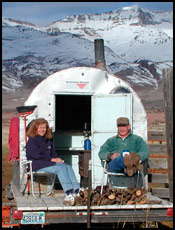
Ron Torell with his wife, Jackie.
Cow Camp Chatter
Leasing cows
Given the current record-high livestock market, many stockmen who find themselves short on cattle with extra feed and not enough money are considering leasing cows.
Historically, beef cows have been leased on either a cash or share of calf crop basis, with share leases being the most common. A calf share-lease arrangement is a good way to transfer ownership of cows to others over time with the possible benefit of income tax reductions compared to an outright sale. Share-lease agreements have been used very successfully as a means to enter or re-establish a herd with minimum borrowed capital.
So, what is a fair and equitable share-lease agreement? It depends.
Every ranch has different resources and different costs associated with the production of beef. It is for this reason a 60/40 or 70/30 split-lease arrangement used by your neighbor may not be equitable for your operation.
Considerations
The first step to take when considering a lease agreement is to know your per-head input costs and projected production levels. Be conservative with both production and marketing estimates. Know what it costs to produce a calf.
Do not cook the books! Too often we only include the obvious out-of-pocket costs such as feed, veterinary, medicine, death loss, breeding, marketing and transportation figures. Take into account all hidden costs, such as depreciation, interest, opportunity value of your money, labor and taxes.
Perform a complete cow-calf enterprise budget analysis for your operation. You will be amazed at how much it actually costs to produce a calf. The hidden costs add up and are indisputable.
Once you have established the cost of production and ownership you'll have a baseline starting point. The devil is in the details. Consider the following:
- Who provides and feeds the bull and what quality of bull is to be used?
- Who receives revenues from market-ready cow sales?
- Who infuses replacement animals back into the herd?
- What is the veterinary medicine protocol to be followed?
- Who suffers death loss?
- Are there adjustments made dependent on market fluctuations?
- What nutritional and mineral program is to be followed?
- Is there an expected minimum cow body condition to be maintained?
- What time frame is the lease to be maintained?
These are only some of the essential specifics that need to be addressed in a written contract so there are no surprises when it comes to a fair and equitable share-lease agreement.
Cash vs. share lease
A cash lease is the easiest to calculate and may be the simplest to understand. It is the type of lease often preferred by outside non-agriculture lease investors. For example, if the fair market value on Nov. 1 is $1,300 for a middle-aged, March-calving cow in moderate body condition, and a 6% annual rate of return on investment is desired, one could easily establish a $78 ($1,300 x 0.06) cash-lease price.
If all inputs and risk associated with owning said livestock are to be shouldered by the lessee with a guarantee of the same described cow returned the following Nov. 1, then a lower rate should be negotiated. However, if the lessor is willing to accept some of the risk and/or share in some of the inputs, then a higher rate could be negotiated.
Plug the cash lease figure you are considering into the cow-calf enterprise budget analysis developed earlier and confirm it as an economically viable option. A cash lease shifts market downturn risk to the lessee and leaves the lessor out on any market upticks.
Comparing share-lease agreements to full ownership options is much more difficult. In most share-lease agreements the cows and bulls are furnished for a set share of the calves. As the market rises the share percentage remains the same, however, there are more dollars to go around. Both parties share the marketing and production risk or rewards at the set established percentage. Cow owners generally realize market-ready cow sales and also provide replacement animals for the herd.
Every share-lease agreement is different because every lessee and lessor has different resources and different reasoning for entering into the agreement.
Resource considerations
When contemplating a lease agreement, it's necessary to take into consideration ranch resources, feed and the quality of the cows together with their adaptability and hardiness. This is especially true in harsher environments such as those found in tough desert regions. Not all cows are created equal. Feed resources vary tremendously from ranch to ranch and year to year. Cattle must be matched to the resources. Managers must have an alternative plan should a drought or other unforeseen circumstance arise that requires a management course change. For example, leasing irrigated pasture cows and managing those animals in the desert will be a wreck for all parties involved, including the cows and the banker.A lease that favors one party over another is doomed for failure. In up market years, lease agreements work well because there is plenty of money to go around. During down markets, it's a different story. In poor marketing years calf sales often fail to cover production costs, leaving no profits to share. Share agreements need to be flexible to account for unforeseen circumstances that are certain to arise. The days of handshake deals are gone. Have a written contract that spells out the details on both sides of the agreement. Deal only with credible people who are good livestock handlers/managers who subscribe to and practice honesty, integrity and good stewardship of the land.
That's enough for this month. A special thanks to my wife, Jackie, for her part in writing "Cow Camp Chatter." As always, if you would like to discuss this article or simply want to talk cows, do not hesitate to contact me at 775-385-7665 or e-mail me.











